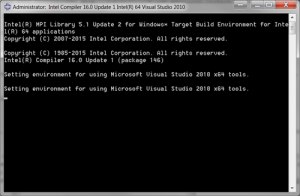

There is nothing preventing rigid body motion in the Y-direction, so the whole thing just shuffles along.Īpart from that, you'll want to add the relevant history output variables for the cavity (see below), and I would recommend reducing your output intervals by a couple orders of magnitude, otherwise your odb will just be excessively big. Your second big issue is that your boundary conditions are insufficient. My understanding is that you never actually define fluid elements (FAX2, F2D2 etc.) in an input file, Abaqus does that internally. I just deleted your membrane elements and it ran without errors. I don't know if defining the cavity with the membrane elements would be sufficient. The error that I got, though, was that the membrane elements were missing a property (you gave a density but didn't define an elasticity etc.). "c:\Program Files (x86)\Microsoft Visual Studio 9.0\VC\bin\x86_amd64\vcvarsx86_amd64.bat" & "c:\Program Files (x86)\Intel\Compiler\11.1\072\bin\intel64\ifortvars_intel64.bat" & & C:\SIMULIA\ Abaqus\Commands\abq6121.Based on the input file, you created membrane elements that shared nodes with the the solid ones, but the cavity was associated with the solid element surface and not the membrane. Start -> Programs -> Abaqus -> Abaqus CAE -> Right click-> Properties If you got all what you needed "PASS" then you can do the same thing to the ABAQUS CAE "verify.log" in ABAQUS default temporary folder to see it.

This guide contains a complete description of all the user subroutines. Initial conditions in Abaqus/Standard and Abaqus/Explicit, Section. An example of adding a GUI plug -in to the Plug-ins menu. Alternatively you can open the summary file The first plug-in computes all the requested quantities (MCFs) and then adds.
Abaqus 6.13 code#
(Abaqus 6.13, Microsoft Visual Studio 2010, Intel Parallel Studio XE 2013) Couple of questions-1) Error: Problem during compilation: What is wrong with the code below subroutine uhyper (A former student had this subroutine.
Abaqus 6.13 verification#
(You might need to cut off the part || notepad.exe verify.log which to call notepad to open verify.log file when finish as the command is too long)ĭuring the verification process, you would be able to see if all requirements are PASSED or not. For a newbie at Abaqus with subroutines, After months of trying, finally installed Abaqus, verified results all passed. "c:\Program Files (x86)\Microsoft Visual Studio 9.0\VC\bin\x86_amd64\vcvarsx86_amd64.bat" & "c:\Program Files (x86)\Intel\Compiler\11.1\072\bin\intel64\ifortvars_intel64.bat" & C:\SIMULIA\Abaqus\Commands\abq6121.bat -verify -all -log & notepad.exe verify.log
Abaqus 6.13 32 bit#
Please note that if your system is 32 bit or your installed folder not the same then you should change the link accordingly.

Start -> Programs -> Abaqus -> Abaqus Verification -> Right click on PropertiesĬ:\SIMULIA\Abaqus\Commands\abq6121.bat -verify -all -log & notepad.exe verify.log || notepad.exe verify.logĪdd the path of the files vcvarsx86_amd64.bat in VS and ifortvars_intel64.bat from Compiler to that: If you check all of those in good order, you can proceed with next steps:

I used to have newer versions of VS and Intel Compiler installed and end up with re-install the whole thing to older versions to get them work with ABAQUS. You must make sure the versions of those packages supported by the version of your ABAQUS, otherwise, it never works. I have not upgraded to ABAQUS 6.13 yet so not sure which version of Visual Studio and Intel Compiler are supported now. The first plug-in computes all the requested quantities (MCFs) and then adds. I used to have too much trouble with linking ABAQUS with Fortran, the main reason is I used NOT compatible versions between them.


 0 kommentar(er)
0 kommentar(er)
